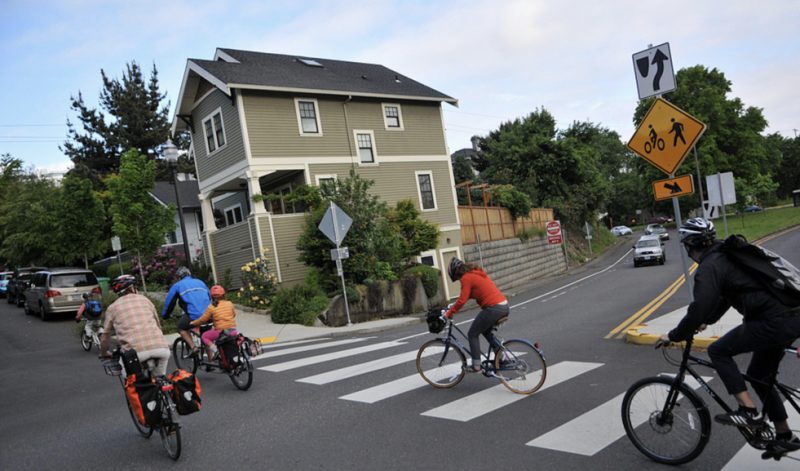
The “safety in numbers” phenomenon works in housing too.
(Photo: Jonathan Maus)
This is a guest post by Michael Andersen, BikePortland’s news editor from 2013 to 2016. He’s a writer for 1000 Friends of Oregon’s pro-housing campaign Portland for Everyone.
There are two ways for more Portlanders to live in bikeable neighborhoods.
One way is to add good bike infrastructure to neighborhoods without it. The other way is to let more people live in neighborhoods that have it already. Portland should be doing both.
A proposal to increase the number of small and mid-size homes in Portland’s bikeable areas — allowing “gentle density” like duplexes, corner triplexes and double ADUs in the neighborhoods we banned them from in 1959 — is at the city planning commission this month, and it needs your help.
Duplexes and triplexes = cheaper family-size homes
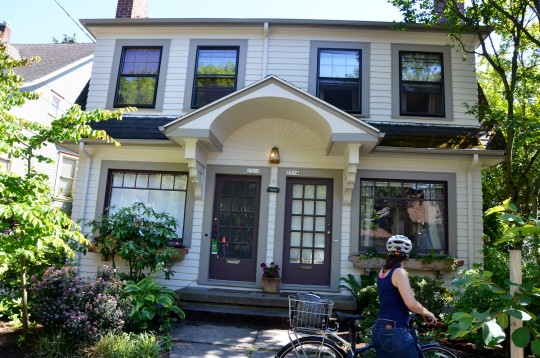
A duplex on SE Salmon.
(Photo: Michael Andersen)
Longtime BikePortland readers may remember watching, a few years ago, as I gradually became more and more obsessed with housing policy. In 2014, we were sounding the alarm on Portland’s deepening housing shortage; the next year, the average Portland monthly rent shot up $100 … with even faster hikes in older buildings.
Thanks to a big wave of new apartment buildings since — made possible in part by the falling demand for parking garage space that has made thousands of low-car homes financially viable — we’ve finally seen rents flatten out, at least on average. But that just means the housing crisis is no longer getting worse. If we’re going to bring Portland’s housing prices back down and prevent future crises, we need to change the game. We need to find ways to get more homes for the same cost.
Duplexes, triplexes and narrow lots do this. Two-story wood buildings are 19 percent cheaper to build per square foot than five-story apartment buildings, which means they’re the best path to creating new family-size housing that doesn’t cost a fortune.
The main reason we don’t have more of these small homes is that it’s mostly illegal to build any more of them. Today, 59 years after the city banned attached housing from most of its residential areas, that last generation of duplexes is still sitting in front of us, doing their jobs as the only homes on the block on sale for less than $260,000 each (for example).
More proximity = more biking
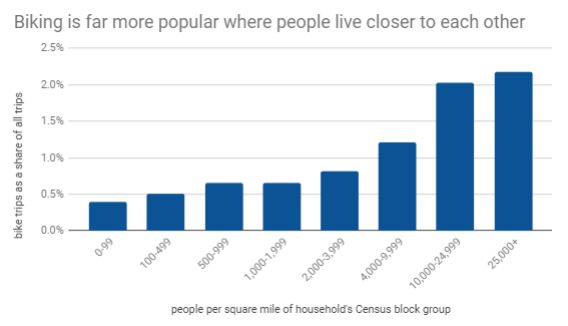
Data: 2017 NHTS. Chart: Michael Andersen.
My predecessor Elly Blue wrote in 2007 that proximity is the key to Portland’s bikey future. Data released last month by the 2017 National Household Travel Survey shows that she was right.
The closer people in a neighborhood live to each other, the more likely they are to get around by bike. Moving from an area with 2,500 residents per square mile (like, say, Tualatin) to one with 5,000 residents per square mile (like Parkrose) roughly doubles the chance that you’ll use a bike for a given trip. Moving from Parkrose to a place with 12,000 residents per square mile (like the Belmont, Hawthorne, 28th or inner Alberta districts) doubles it again.
How close you live to other people is a much better predictor of your biking habits than age, race or income. And it’s more effective at increasing your biking habits than a lot of possible street improvements.
This isn’t really a surprise. Even most Dutch people don’t bike for more than three miles or so. The thing about Dutch cities is that they don’t have to. Residential density means the Dutch aren’t far from a lot of the other people they want to visit, and because more people live nearby, there’s enough demand to support lots of businesses within biking distance, too.
Most of Portland’s east side is in that 4,000-10,000 range on the chart above — the third bar from the right. But Buckman, Sunnyside, Kerns and Richmond (Portland neighborhoods with some of the highest bike-commuting rates in North America) are in the 10,000-25,000 range.
Why the difference in density? In part, it’s because those were all neighborhoods we built before we banned small multifamily buildings from most residential areas.
Weigh in now for more duplexes and fewer McMansions
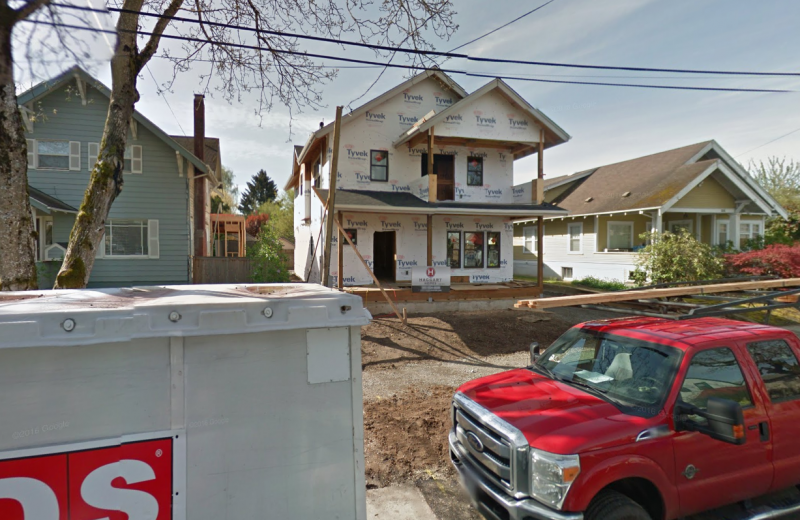
(Image: Michael Andersen)
I’ll spare you the fine print of the city’s “residential infill project” proposal unless you want it. (And if you do, I would love to talk to you about the possibility of using a modest FAR bonus and a bonus unit to create an affordability incentive targeted to households at or below 80% MFI.)
The short version is that the plan would re-legalize duplexes, corner triplexes and double granny flats (one attached ADU, one detached ADU) in the middle parts of the city.
This is a deeply controversial concept among people who become upset about the possibility of sometimes needing to park down the block from their house, and those who didn’t seem worried about Portland’s changes until they started to affect buildings instead of just people.
The current proposal would reduce demolitions citywide by setting a new cap on building sizes that would apply no matter how many homes are in a building. (This is why, contrary to the wild-eyed claims of Stop Demolishing Portland activists, it wouldn’t result in mass demolition of existing homes for monster duplexes — new small buildings would rarely be able to sell for enough to pay for both demolition and construction of something new, so current buildings will almost always remain.) This would end most of the 1:1 demolition/McMansion projects that only accelerate middle-class displacement.
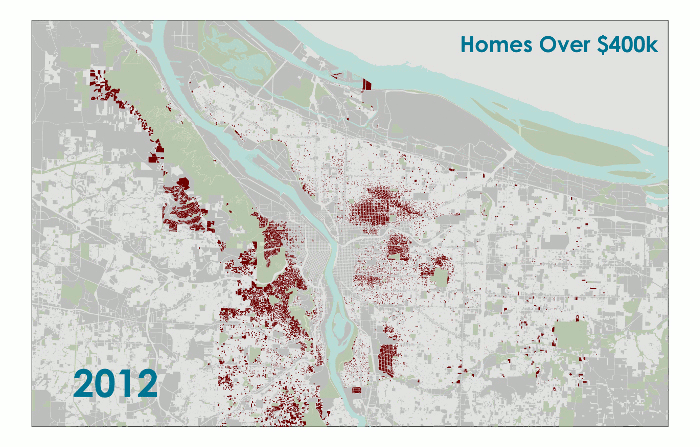
At $400,000, 58 percent of Portlanders are essentially excluded from homeownership. Data: Metro. Images: Mike Sellinger.
The Planning and Sustainability Commission is hearing live testimony for the first time this evening. The online comment deadline is next Tuesday, and the commission’s second and final public hearing will be that night.
There are ways to make the proposal better for density and affordability; if you’re interested, I gave my take on the four most important changes halfway down this post. (The last one: End mandatory parking requirements citywide.) But the bottom line is that in tomorrow’s Portland, for the sake of both housing and transportation, we’re going to need more homes. We should make it legal to fit them in.
The online testimony form is here.
— Michael Andersen: (503) 333-7824, @andersem on Twitter and michael@friends.org
Never miss a story. Sign-up for the daily BP Headlines email.
BikePortland needs your support.
The post Speak up or sprawl out: “Missing middle” housing proposal hits the planning commission tonight appeared first on BikePortland.org.
from BikePortland.org https://ift.tt/2rp7Ree


No comments:
Post a Comment